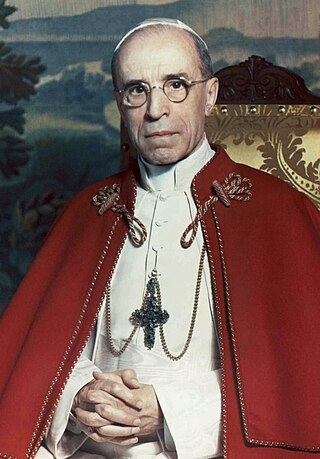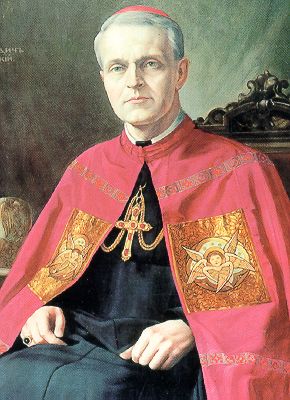Related Research Articles

Pope Pius XII was head of the Catholic Church and sovereign of the Vatican City State from 2 March 1939 until his death in October 1958. Before his election to the papacy, he served as secretary of the Department of Extraordinary Ecclesiastical Affairs, papal nuncio to Germany, and Cardinal Secretary of State, in which capacity he worked to conclude treaties with various European and Latin American nations, including the Reichskonkordat treaty with the German Reich.

During World War II, some individuals and groups helped Jews and others escape the Holocaust conducted by Nazi Germany.

Righteous Among the Nations is an honourific used by the State of Israel to describe all of the non-Jews who, for purely altruistic reasons, risked their lives in order to save Jews from being exterminated by Nazi Germany during the Holocaust. The term originates from the concept of ger toshav, a legal term used to refer to non-Jewish observers of the Seven Laws of Noah.

The Myth of Hitler's Pope: How Pope Pius XII Rescued Jews from the Nazis is a 2005 book by American historian and Rabbi David G. Dalin. It was published by Regnery Publishing.

Sára Salkaházi, SSS was a Hungarian Catholic religious sister who saved the lives of approximately one hundred Jews during World War II. Denounced and summarily executed by the pro-Nazi Arrow Cross Party, Salkaházi was beatified in 2006.

Angelo Rotta was an Italian prelate of the Catholic Church. As the Apostolic Nuncio in Budapest at the end of World War II, he was involved in the rescue of the Jews of Budapest from the Nazi Holocaust. He is a significant figure in Catholic resistance to Nazism.

Jules-Géraud Saliège was a French Cardinal of the Roman Catholic Church. He served as Archbishop of Toulouse from 1928 until his death, and was a significant figure in Catholic resistance to Nazism in France. He was elevated to the cardinalate in 1946 by Pope Pius XII. For his efforts to protect Jews during the Nazi Holocaust he was recognised as Righteous among the Nations by Yad Vashem.

Pavel Peter Gojdič, was a Rusyn Basilian monk and the eparch of the Slovak Greek Catholic Eparchy of Prešov. He died while imprisoned by the StB, the secret police of the communist regime in Czechoslovakia. He was beatified by Pope John Paul II in 2001 and recognised as Righteous Among the Nations by Yad Vashem in 2007.
The relations between Pope Benedict XVI and Judaism remained fairly good, although concerns were raised by Jewish leaders over the political impact of Traditionalists in the Church during the papacy of Benedict.
Pope John Paul II worked to improve relations between the Roman Catholic Church and Judaism. He built solid ties with the Jewish community in the hope of promoting Christian–Jewish reconciliation.

The relations between Pope Pius XII and Judaism have long been controversial, especially those questions that surround Pope Pius XII and the Holocaust. Other issues involve Pius's Jewish friendships and his attitude towards the new state of Israel.
The relations between Pope John XXIII and Judaism are generally thought to have been among the best in the bi-millennial history of Christianity. The Pope initiated a policy of Christian–Jewish reconciliation after his election to the papacy in 1959, which focused on the Second Vatican Council producing a document on the relationship between the Catholic Church and the Jews. During his earlier career in the diplomatic service, especially during World War II, he had taken a series of actions that demonstrated his solidarity with victims of anti-Semitism.
Pope Pius XII's response to the Roman razzia, or mass deportation of Jews, on October 16, 1943 is a significant issue relating to Pope Pius XII and the Holocaust. Under Mussolini, no policy of abduction of Jews had been implemented in Italy. Following the capitulation of Italy in 1943, Nazi forces invaded and occupied much of the country, and began deportations of Jews to extermination camps. Pius XII protested at diplomatic levels, while several thousand Jews found refuge in Catholic networks, institutions and homes across Italy, including in Vatican City and Pope Pius' Summer Residence. The Catholic Church and some historians have credited this rescue in large part to the direction of Pope Pius XII. However, historian Susan Zuccotti researched the matter in detail and states that there is "considerable evidence of papal disapproval of the hiding of Jews and other fugitives in Vatican properties."
The conversion of Jews to Catholicism during the Holocaust is one of the most controversial aspects of the record of Pope Pius XII during The Holocaust.
Yad Vashem, the state of Israel's official Holocaust memorial, has generally been critical of Pope Pius XII, the pope during The Holocaust. For decades, Pius XII has been nominated unsuccessfully for recognition as Righteous Among the Nations, an honor Yad Vashem confers on non-Jews who saved Jewish lives during the Holocaust altruistically and at risk to their own lives.
Sister Margherita Marchione was an American Roman Catholic sister, writer, teacher and apologeticist, who dedicated herself in her later years to the defense of Pope Pius XII.
The canonization process of Pope Pius XII dates to shortly after his death in 1958. He was declared a servant of God in 1990 and venerable in 2009. Father Peter Gumpel was the relator of Pius XII's cause for canonization. The potential beatification of Pius XII has raised concern, especially by Jewish organisations, because of his controversial record during the Holocaust. The objections especially arise because of the refusal by the Vatican to allow independent access to the Vatican's archives for the period of Pius XII's papacy.

Catholic resistance to Nazi Germany was a component of German resistance to Nazism and of Resistance during World War II. The role of the Catholic Church during the Nazi years remains a matter of much contention. From the outset of Nazi rule in 1933, issues emerged which brought the church into conflict with the regime and persecution of the church led Pope Pius XI to denounce the policies of the Nazi Government in the 1937 papal encyclical Mit brennender Sorge. His successor Pius XII faced the war years and provided intelligence to the Allies. Catholics fought on both sides in World War II and neither the Catholic nor Protestant churches as institutions were prepared to openly oppose the Nazi State.
During the Holocaust, the Catholic Church played a role in the rescue of hundreds of thousands of Jews from being murdered by the Nazis. Members of the Church, through lobbying of Axis officials, provision of false documents, and the hiding of people in monasteries, convents, schools, among families and the institutions of the Vatican itself, saved hundreds of thousands of Jews. The Israeli diplomat and historian Pinchas Lapide estimated the figure at between 700,000 and 860,000, although the figure is contested.
The Finaly Affair was a legal dispute over the custody and kidnapping of Robert and Gerald Finaly, two Jewish children whose parents were murdered in the Holocaust. The fight for custody resulted in kidnapping charges against Antoinette Brun, the children's war-time guardian who defied court orders to surrender the boys to their surviving relatives after World War II. Catholic clergy members were also charged with kidnapping after hiding the children in Catholic institutions.
References
- ↑ "Pius' children". 31 March 2006.
- ↑ Sciolino, Elaine; Horowitz, Jason (9 January 2005). "Saving Jewish Children, but at What Cost?". New York Times. Retrieved 19 January 2018.
- ↑ Jerusalem Report, 7 February 2005
- ↑ Kertzer, Story by David I. "The Pope, the Jews, and the Secrets in the Archives". The Atlantic. ISSN 1072-7825 . Retrieved 2020-08-29.
- ↑ Povoledo, Elisabetta (2020-08-28). "Unsealed Archives Give Fresh Clues to Pope Pius XII's Response to the Holocaust". The New York Times. ISSN 0362-4331 . Retrieved 2020-08-29.
- ↑ Joyce Block-Lazarus. In the Shadow of Vichy. The Finaly Affair. Peter Lang. 2008. ISBN 1-4331-0212-9, ISBN 978-1-4331-0212-7.
- ↑ Baudy, Nicolas (1 June 1953). "The Affair of the Finaly Children: France Debates a Drama of Faith and the Family". Commentary. Retrieved 10 January 2018.
- ↑ "Leokadia Jaromirska". Yad Vashem. Retrieved 19 January 2018.
- ↑ Hellman, Peter (1980). Avenue of the Righteous . Atheneum. ISBN 9780689111099.[ page needed ]
- ↑ Hellman, Peter (1994). The righteous Gentiles of the Holocaust: a Christian interpretation. Fortress Press.[ page needed ]
- ↑ "ADL to Vatican: Open Baptismal Records and Put Pius Beatification on Hold" (Press release). Anti-Defamation League. 13 January 2005. Archived from the original on 4 January 2009.
- ↑ Foxman, Abraham H. (23 January 2005). "60 Years Later, Baptized Jews Deserve Truth From Vatican" (Press release). Anti-Defamation League. Retrieved 19 January 2018.
- ↑ "ADL Position on Pope Pius XII (September 18, 2008)". Archived from the original on December 25, 2008. Retrieved May 4, 2009.
- ↑ Fendel, Hillel (22 April 2009). "Call for Pope to Reveal Hidden Holocaust Children". Israel National News. Retrieved 20 January 2018.
